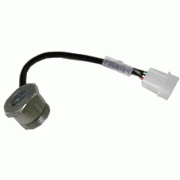 For this article, we’ve selected to explain the working principles of the RPM standard sensor for the pressurized Bendix series (manufactured by Teledyne Continental Motors):
For this article, we’ve selected to explain the working principles of the RPM standard sensor for the pressurized Bendix series (manufactured by Teledyne Continental Motors):
The RPM sensor is connected to the magneto. To understand the sensor let us first begin with the “why” of things i.e. why is the magneto required in the first place is:
A magneto is required to power the sparkplug. Every combustion engine (including those used in aircraft), have sparkplugs. These provide the ignition or fire required to ignite the fuel-air mixture in the combustion chamber. The sparkplug purpose and functioning are identical to the gas lighters that your mom used to have; but are now built into the gas range in your home.
To work properly, the sparkplugs in turn require an awful lot of electrical volts to create the spark. And this electrical power needs to be very precise and delivered at the right moment.
A battery would not do the job efficiently so a custom-built power generator called the “magneto” was invented.
As the output power from the magneto needed to be precise, it therefore needed to function with precision. A malfunctioning magneto will mean that everything downstream will also malfunction. So, the pilot(s) need to know the instant the magneto isn’t working as intended.
Enter the RPM sensor. To understand the working principle of the RPM sensor, it is important to know a bit about the magneto itself.
The Magneto is basically a dynamo with a rotating magnet, a built-in breaker switch, a transformer and a distribution system to channel the power to the spark plugs. For reasons mentioned above, it is important that the magnet rotates at a speed that is within the prescribed range otherwise your spark plugs (and hence the engine) will misfire. To ensure that is so, you need the aircraft RPM Sensor. The RPM standard Sensor plugs directly into the magneto and transmits data to your EDM / RPM Gauges in the cockpit.
The Aircraft Level Sensors you use will depend on the magneto brand and model inserted in your aircraft.
If you need to install a new RPM sensor, make sure:
• The new RPM Sensor is precisely aligned with the correct vent plug of the magneto. Here’s how you do it: peep into the magneto hole and you should see the rotating magnet in this hole. If you see anything other than the rotating magnet e.g. the ‘gear’, then you’re on the wrong vent.
• When everything is connected and the engines fired up, the Digital Gauges in the cockpit should read 2400 rpm for a 6-cylinder engine or 1800 rpm for 8-cylinder or 1600 for a 9-cylinder engine.
If you have a 4-cylinder engine with a dual mag, the rpm should be 1800 and for a 6-cylinder engine with dual mag, it should be 2400.
• The red wire to the RPM standard sensors should be supplying 5v+.
More information on JPI manufactured RPM standard sensors here: https://www.jpinstruments.com/shop/rpm-sensor-for-bendix-mag/

